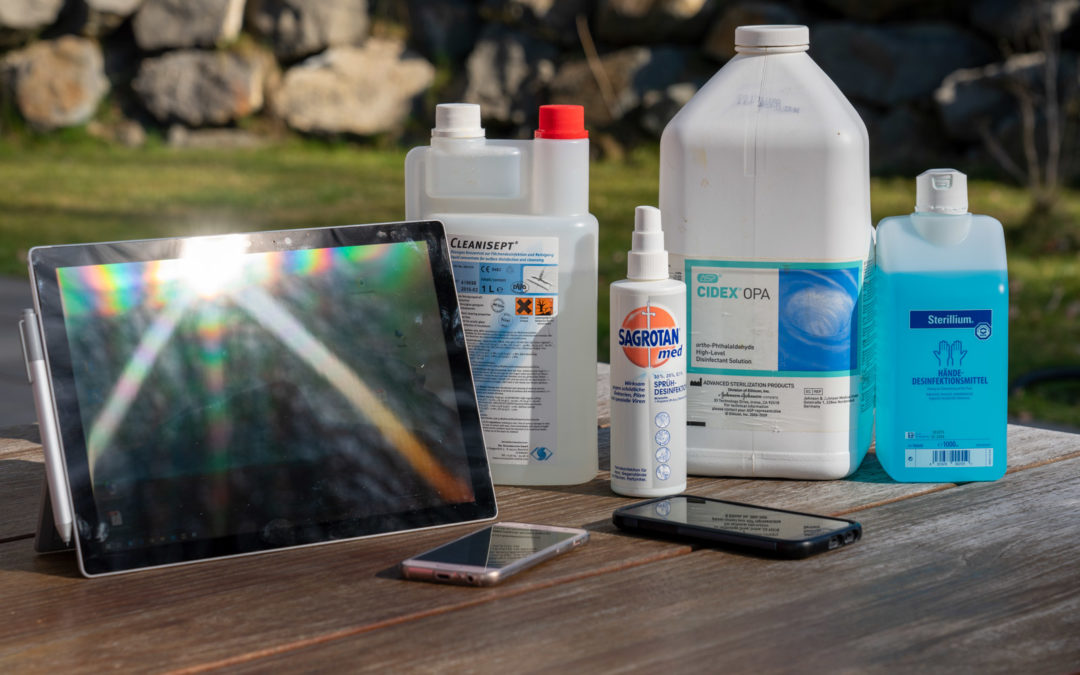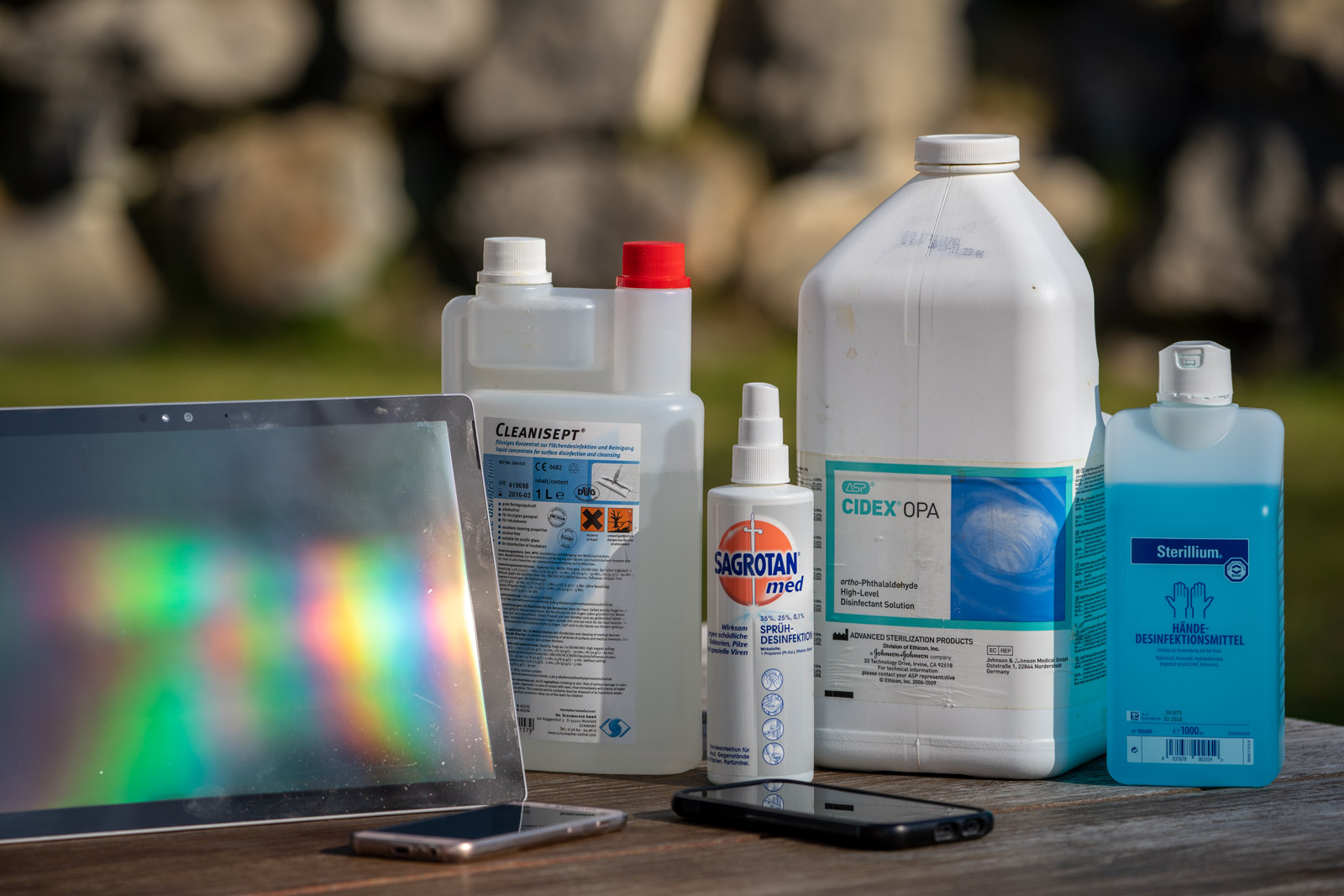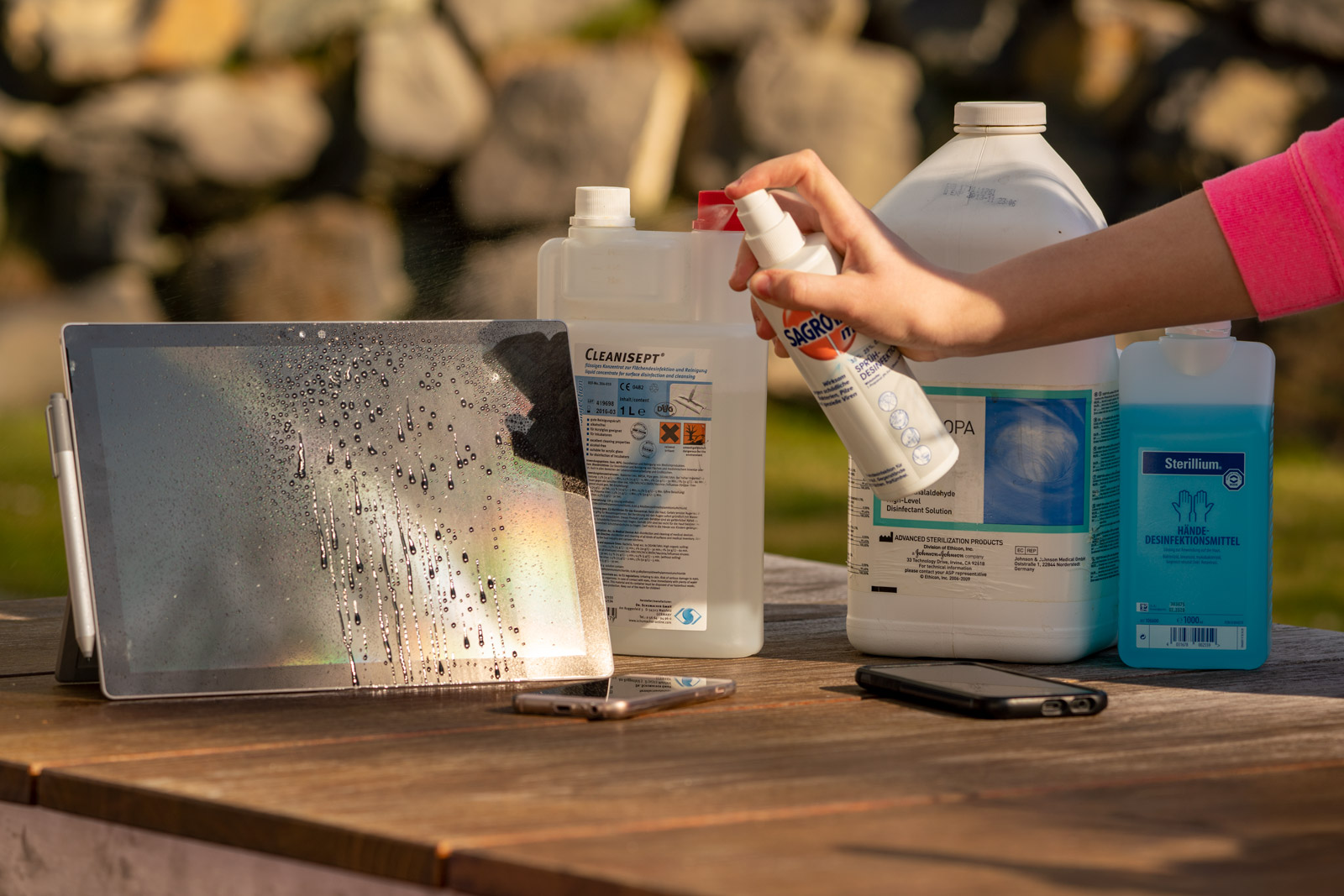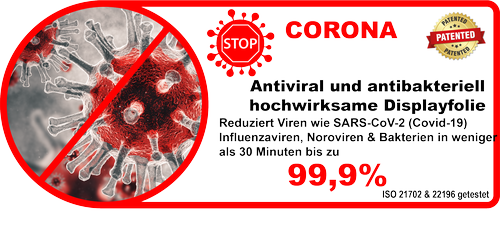Disinfection of touchscreen, tablet, cell phone and co.
Neoxum Displayschutz, sowohl als Neoxum Displayfolie als auch als OnScreen® Hybridglas sind beständig gegen viele Desinfektionsmittel. Somit werden Touchscreen Displays, Monitore, Handys, Tablets und viele Gerätedisplays mehr, vor aggressiven Desinfektionsmitteln geschützt. Keine Sorge mehr um das Display trotz Desinfektion in dieser angespannten Corona Krise.
Ausführliche Testberichte sind im Downloadbereich verfügbar.
Überlebenszeit des Coronavirus auf Oberflächen
Nach einer Studie von US Wissenschaftlern zur Überlebenszeit Coronavirus auf Oberflächen („Aerosol and surface stability of HCoV-19 (SARS-CoV-2) compared to SARS-CoV-1”) [1] konnte nachgewiesen werden, dass das neuartige SARS-CoV-2 Virus, wie das Corona Virus korrekt heißt, bis zu 4 Stunden auf Kupferoberflächen und bis zu 24 Stunden auf Kartonagen und Karton überlebt. Auf Kunststoffoberflächen und Plastik, sowie rostfreiem Stahl, überlebt das Corona Virus zwei bis drei Tage. Leider finden sich keine Aussagen zur Überlebenszeit auf Glasoberflächen. Es ist jedoch davon auszugehen, dass sich diese denen von Stahl ähneln, also 2-3 Tage.
Im Fall von Kunststoffoberflächen von Touchscreens, Displays, Handys und Monitoren etc., die ständig in Kontakt mit den Fingern sind, bleibt der Erreger für diese zwei bis drei Tage aktiv, so dass potentiell weitere Personen mit der Covid-19 Krankheit infizieren könnten.
Infektion über den Weg von Touchscreen, Handy und Co.
In vielen Unternehmen sind Touchscreen und Displays aus dem Alltag aber nicht mehr wegzudenken. Denken wir alleine an die Bedienterminals an Maschinen, Touchscreen von medizinischen Geräten, an die Unterschrift auf den Zebra, Honeywell, Cipherlab, Datalogic Geräte dieser Welt, die wir leisten, wenn wir Pakete entgegennehmen oder auch im Lager Warenbewegungen quittieren. Nur eine gründliche Desinfektion der Displayoberfläche der Touch Geräte tötet den Virus zuverlässig ab. Dabei sind die Herstellerangaben der Desinfektionsmittelhersteller unbedingt einzuhalten. Der Sterillium Hersteller Bode Chemie schreibt zum Beispiel vor, dass für die Händedesinfektion eine Einwirkzeit von mindestens 30 Sekunden eingehalten werden muss.
Krankheitserreger auf Touchscreens und Displays
Eine Studie der London Metropolitan University [2] kam bereits 2018 zum Ergebnis, dass auf Touchscreens einer bekannten Restaurantkette Fäkalbakterien gefunden wurden, die von Besuchern verschleppt wurden.
Robert-Koch-Institut empfiehlt regelmäßige Reinigung und Desinfektion
Das Robert-Koch-Institut (RKI) gibt klare Empfehlungen und Regeln zum Umgang mit Touchscreens:
„As keyboards and touchscreens are surfaces that are often touched by hand, they represent a possible route for the transmission of pathogens [3-6] and should therefore be taken into account in the hygiene plan.“
[Quelle: RKI][1] https://www.medrxiv.org/content/10.1101/2020.03.09.20033217v1.full.pdf
[2] https://www.londonmet.ac.uk/news/articles/tests-find-traces-of-faeces-on-popular-restaurant-touchscreens/
[3] Rutala WA, White MS, Gergen MF et al.: Bacterial contamination of keyboards: efficacy and functional impact of disinfectants. Infect Control Hosp Epidemiol 2006;27(4):372-7
[4] Fellowes C, Kerstein R, Clark J et al.: MRSA on tourniquets and keyboards. J Hosp Infect 2006;64(1):86-8
[5] Simmons N: Computer keyboards and the spread of MRSA. J Hosp Infect 2006;64(1):88
[6] Brady RR, Verran J, Damani NN et al.: Review of mobile communication devices as potential reservoirs of nosocomial pathogens. J Hosp Infect 2009;71(4):295-300
Stabilität von Touchscreens und Displays gegenüber Desinfektionsmittel
Ob und wie stabil Displays oder Touchscreens über einen längeren Zeitraum gegenüber Desinfektionsmittel sind, will niemand tatsächlich ausprobieren. Alkohole und Alkoholgemische sind neben weiteren Substanzklassen, wie z.B. Aldehyden zur professionellen Desinfektion von Oberflächen zugelassen.
Das Robert-Koch-Institut gibt Hinweise zur Desinfektion von Touchscreens und Bedienoberflächen:
„Touchscreens, wie sie z.B. an Tablets, aber auch an den Bedienoberflächen verschiedener Geräte vorzufinden sind, sind von Herstellerseite oft nicht für eine routinemäßige Desinfektion geeignet. Eine effiziente Desinfektion kann hier zu Schädigungen oder langfristig zum Funktionsverlust führen.“
[Quelle: RKI]
Schutz des Touchscreen Displays vor Desinfektionsmittel
Neoxum produziert widerstandsfähigen Displayschutz auf Basis von PET (Polyethylenterephthalat) Material und in Kombination mit einer Glasbeschichtung, unter OnScreen® Hybridglas. Wir haben schon vor einigen Jahren unsere Materialien einem intensiven Test mit üblichen Desinfektionsmitteln getestet. Aber auch mit Produkten aus dem Klinikbereich zur professionellen Desinfektion wurden Testreihen durchgeführt. Die folgenden Desinfektionsmittel, bzw. deren Hauptbestandteile bei auf Alkohol basierenden desinfizierenden Lösungen, wurden im Test verwendet. Sowohl die Neoxum glasklare Displayfolie, als auch die unsere Antireflexfolie haben den Test bestanden. Auch das flexible glasharte OnScreen® Hybridglas musste den Test absolvieren. Der Neoxum Displayschutz ist mindestens stabil gegen die folgenden getesteten Substanzen:
Bacilliol
Flächendesinfektionsmittel zur Desinfektion von Flächen, medizinischen Geräten, in Krankenhäusern und Altenheimen und Produktion in der Pharmabranche, Lebensmittelbranche und Kosmetikbranche
Cidex®-Opa
Desinfektionsmittel zur Desinfektion von chirurgischen Instrumenten und Flächen. Hochwirksam innerhalb von 5 Minuten gegen viele Mikroorganismen, einschließlich Mycobakterien und Viren.
Korsolex® extra
Aldehydisches Desinfektionsmittel zur Desinfektion medizinischer Geräte. Hochwirksame viruzid nach KRINKO/DVV
Cleanisept®
Desinfektion und Reinigung von medizinischen Geräte, medizinischen Geräte, sowie Oberflächen und Flächen alle Art.
Sterillium®
Sterillium ist ein alkoholisches Desinfektionsmittel zur Hände Desinfektion (aber auch Desinfektion von Flächen)
Sagrotan Med
Sagrotan wird zur Sprühdesinfektion von Haut, Gegenständen und Flächen. Wirksam gegen Bakterien, Pilze und bestimmte Viren.
Isopropanol, 1-Propanol und Ethanol
Reinigungsmittel und Desinfektionsmittel in Kombination mit Wasserstoffperoxidlösung oder Hypochloritlösung
12,5 %-ige Hypochloritlösung
Hypochloritlösung wird als bakterizide und viruzide Desinfektionslösung verwendet.
Wir gehen davon aus, dass unser Displayschutz gegen viele weitere Desinfektionsmittel und Reiniger stabil ist. Tests können nach Absprache durchgeführt werden.





 . A strong 256-bit encryption secures the data transfer. With our externally issued SSL certificate, we are transparent and compliant. In addition to the SSL-secured website, we take data protection very seriously.
. A strong 256-bit encryption secures the data transfer. With our externally issued SSL certificate, we are transparent and compliant. In addition to the SSL-secured website, we take data protection very seriously.
Latest comments